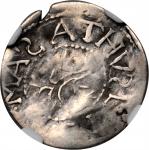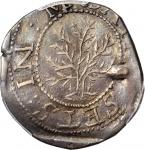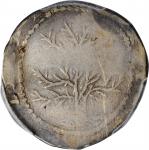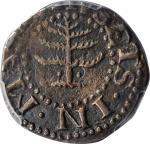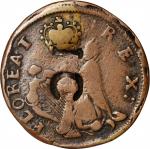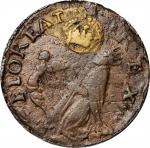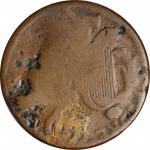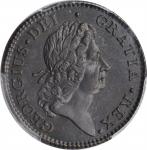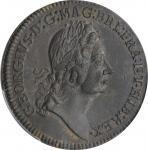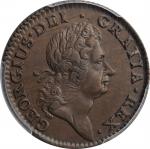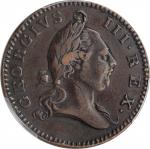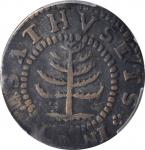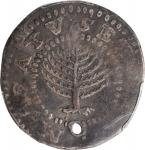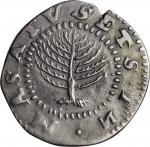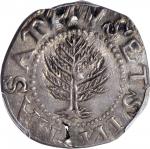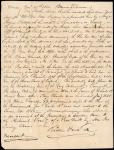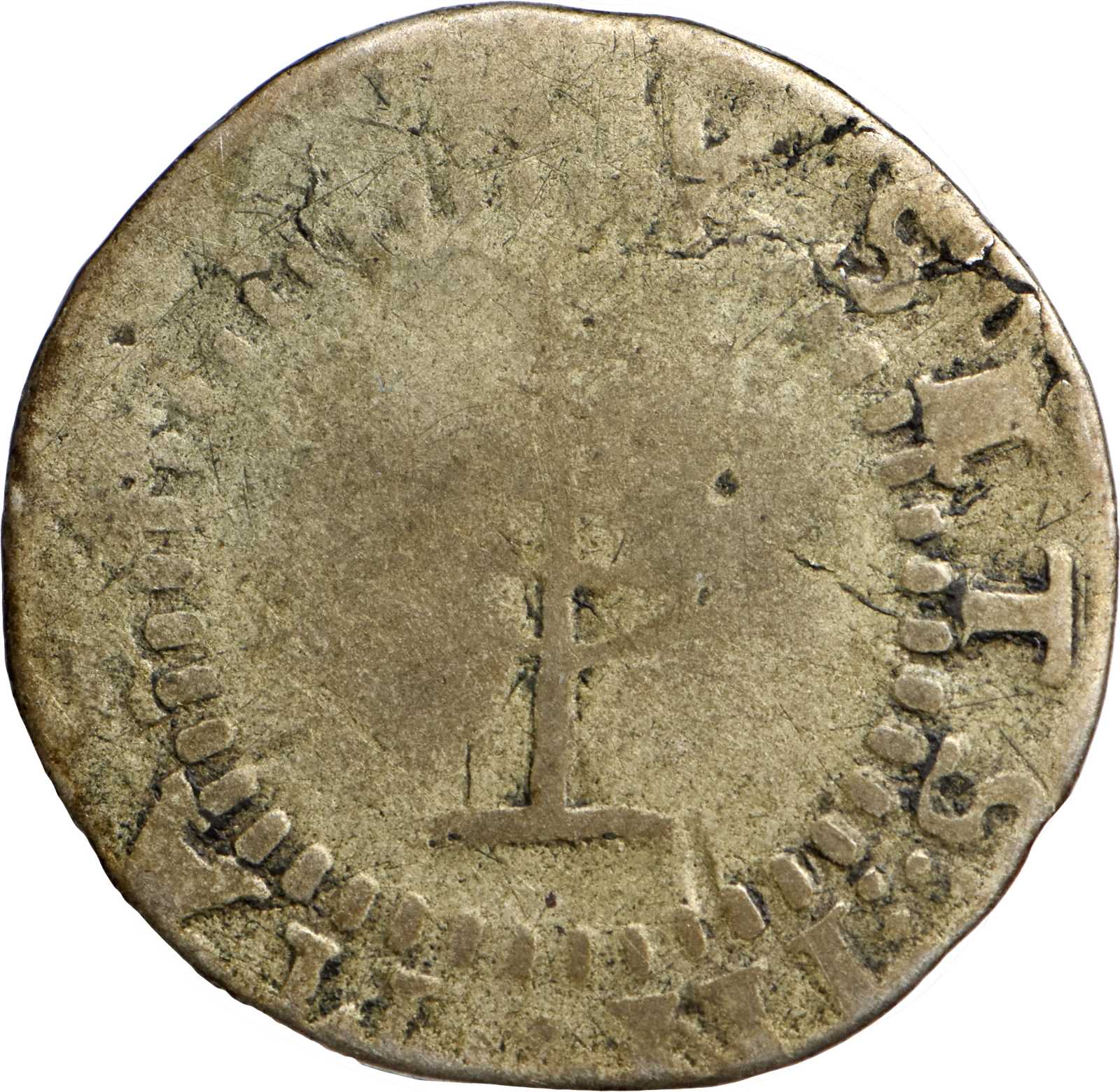1652Pine Tree Shilling. “Small Planchet.” Noe-not listed, Salmon 11-X, Crosby-notlisted. Unique.54.1 grains. 23.6mm x 22.8mm. This is the Discovery Specimen of a new addition to the canon of Massachusetts Silver coinage, a variety pairing Crosby’s reverse K of the unique Noe 12 (Salmon 10-X, Crosby 6-K) Pine Tree Shilling with a previously unknown obverse die. A very thoughtful technical discussion of this new discovery is offered in Christopher Salmon’s “Identification and Classification of an Important New Variety of the Massachusetts Silver Coinage: The Salmon 11-X Pine Tree Shilling” in the June 2019 issue of <em>The Journal of Early American Numismatics (JEAN)</em>, and the story of its discovery is told by Mike Brooks in “Mass Cent on Top, Pine Tree Shilling at the Bottom: Having Fun at Coin Club Leads to Once in a Lifetime Find” in the Summer 2019 issue of <em>The C4 Newsletter.</em> A new die marriage has not been added in the Massachusetts Silver series since the 1967 discovery and publication of Noe 38 (Salmon 3-C, Crosby 22-M,) by Robert Vlack.<p><p><p>In order to understand this new discovery, we need to understand the famous Noe 12, which at some level needs no introduction. It was discovered as part of the Castine Hoard, deposited in 1704 and found in 1840 by Captain Stephen Grindle and his son Samuel. It entered numismatic circulation in W. Elliott Woodward’s October 1863 sale of the collection of Charles Payson of Portland, Maine, an early owner of Noe 12. In the 180 years since its recovery, another example of Noe 12 has not even been rumored to exist. It is unique not only in survivorship, but is the only coin in the Massachusetts Silver series confirmed to have the MASASTHVSETS spelling on its obverse. Its classification has also been inconsistent over the years, considered a Large Planchet issue by some such as Sydney Noe and Q. David Bowers, while classified as a Small Planchet issue by Walter Breen and Don Taxay. This inconsistency is to be expected, as it shares some characteristics of both, while having some characteristics of neither. The style of its pine tree is neither that of the Large nor Small Planchet issues, though admittedly closer to those of the Small Planchets. Its lettering resembles that on the Small Planchet shillings, with the letters seemingly rendered from punches, though the Ns are all backwards. Salmon surmised that the backwards Ns makes the use of punches unlikely, though could the punch itself not have been made backwards? Backwards lettering is seen on the Large Planchet, but not on the Small Planchet issues. It shows none of the waviness associated with having been struck on a rocker press like the Large Planchet issues, and its planchet size is intermediate between the Large and Small Planchet issues, though closer in diameter to the Large Planchets. It is unclipped, though at 62.3 grains, is lighter than any genuine, regular issue of the Boston Mint. Some, like Sydney Noe, Eric Newman and Q. David Bowers have considered Noe 12 a genuine product of the Boston Mint, while Christopher Salmon has listed it in his “Counterfeits and Questionable Varieties” section, believing it instead to be a contemporary circulating counterfeit probably made in the last quarter of the 17th century, when Massachusetts Silver coinage was still in production and active circulation, a dating helped by the fact that it showed obvious wear before becoming part of the Castine Hoard, deposited in 1704. <p><p><p>Given that the new Salmon 11-X variety shares the same exact reverse with Noe 12, as well as its general style and fabric, it stands to reason that Salmon 11-X is also a late 17th century product of the same workshop. Its much more well-worn surfaces preclude any kind of die state comparison to the reverse of Noe 12, though the obverse shows clear sinking in the die in and around the pine tree’s branches; the sinking in the die is manifested by the mounded effect on the struck coin, creating the prematurely advanced wear seen on the pine tree’s branches. It is tempting to conclude that the failure of the obverse of Salmon 11-X necessitated a new obverse die, creating the Noe 12 die pairing. Salmon 11-X weighs only 54.1 grains, and does not show any obvious signs of having been clipped, the very light weight compared to the full 72-grain weight of a Massachusetts shilling furthering the idea that Salmon 11-X is also a probable late 17th century circulating counterfeit. This is unlike other circulating counterfeits like Noe 13, 14 and 31, which are thought to be mid to late 18th century issues created to simulate the well-worn and cut down Massachusetts Silver was still in circulation in the century after production of the genuine coinage had long since ceased. The spelling of the obverse legend is unclear due to the advanced wear, small planchet size and die failure, with only the letters MASA…VSETS IN clearly visible, with a triangular formation of periods before and after IN. There is more than ample space for the unique variant spelling MASASTHVSETS, like that of Noe 12. The reverse legend is as Noe 12’s, NEW ENGLAND AN: DO:, with the triangular formation of periods before and after ENGLAND and the Ns all backwards; 1652 over XII is at center. <p><p><p>Salmon 11-X entered the numismatic fold not through the discovery of a hoard in the depths of Maine, but rather via an estate tag sale in suburban Princeton, New Jersey. Mike Brooks, a collector of US coins, happened upon the tag sale between jobs one day during the third week of October 2017. He noticed a rusty old cookie tin filled with buttons and foreign coins but with a copper Massachusetts Cent laying on top—a coin with which he was familiar as a result of the enthusiastic and infectious educational presentations of tireless promoter of colonial numismatics Ray Williams at the Trenton (NJ) Coin Club. Mike was able to acquire the whole tin for a whopping $5, which after further examination was found to include another Massachusetts Cent, a Connecticut Copper, a Fugio Copper, and a worn out Pine Tree Shilling! Mike took these to the next Trenton Coin Club meeting to show Ray for his attribution expertise. The coppers turned out to be more common varieties, but the Pine Tree Shilling temporarily stumped Ray, so he asked Mike if he could take it home to puzzle it out. Less than 2 weeks later, Ray called Mike back with the good news—that his Pine Tree Shilling was a new discovery, pairing the reverse of the unique Castine Hoard Noe 12, with a previously unknown obverse! Needless to say, Mike was shocked at his luck and good fortune. <p><p><p>The new find was shown to Chris Salmon, the current torchbearer for all things Massachusetts Silver. At first skeptical that the reverse die was a match to that of Noe 12, Chris made the match after realizing that some minor double striking had slightly skewed the details of the reverse, which had at first blush made the initial match to Noe 12’s reverse difficult. Chris assigned the 11-X attribution in his attribution scheme, the X meaning that he counted it among the “Counterfeits and Questionable Varieties,” a way station for contemporary counterfeits and coins needing further study or new information for proper classification. Though die-linked to a Noe-listed die marriage, a Noe number was not assigned due to the inflexibility and awkwardness of Noe’s system, which numbers the series continuously through the denominations and leaves no room for new discoveries in any of the denominations without potentially placing new discoveries out of denomination sequence. <p><p><p>Discoveries of potentially new contemporary counterfeits in the Massachusetts silver series have been made over the decades, but they have had trouble gaining traction as 17th or 18th century productions, the waters muddied by the counterfeits and fantasies that have been made to sell into the numismatic trade since the popularization of coin collecting in the US in the 1850s. The Salmon 11-X is in a different boat altogether, having a solid die-linked connection to a coin—Noe 12—that has an incontrovertible link to the late 17th century, as outlined above. Whether an oddly styled product of Hull and Sanderson’s Boston Mint, or a contemporary circulating counterfeit meant to fool the 17th century New Englander, the Salmon 11-X is a unique survivor of a die combination that will be a keystone in a complete collection of Massachusetts silver coinage. This coin is well worn, and though graded Good-4 by PCGS, a technical grade in the VG range is perhaps more appropriate, as the advanced wear to the obverse is accentuated by the sunken and failing state of the obverse die. Its greenish silver-gray, wholly original surfaces are the undoubted result of extended storage with other loose coinage. A few minor as-made, thin planchet laminations in upper right quadrant of obverse and at central reverse will forever hallmark this specimen as the Discovery Coin. The unique Noe 12 Pine Tree Shilling, graded EF-45 by NGC, sold in November 2017 as part of the Newman collection for $102,000, a price that correlates with its rarity and the important story it tells of the 17th century New England economy. Though more well-worn in comparison, we believe that this newly discovered Salmon 11-X will bring a price similarly in line with its quality and great significance in the first coinage in the English colonies, the 1652-dated silver coinage of the Massachusetts Bay Colony.<p><p><em>Discovered by Ray Williams in a cookie tin ofold coins found in October 2017 by collector Mike Brooks at an estate tag salein Princeton, NJ. <p></em>


